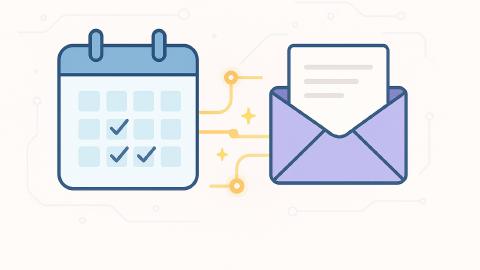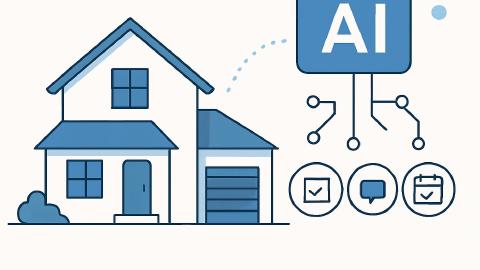How to Write a Professional Email in 2026: Ultimate Guide
Use this guide to learn how to write a professional email, how to start an email, and how to send an email in 2026.
Professional emails are stressful to write. It's easy to worry about sounding too casual, too formal, or just not knowing what to say.
The number of emails sent every second is over 3 million, research shows.
With people receiving so many emails every day, writing clear and professional emails has become more important than ever.
In this article, we'll break down how to write a professional email, how to start an email, and how to end an email in 2026.
Why Is It Important to Write Emails Professionally?
If you're emailing a boss, teacher, recruiter, or coworker, how you write matters. A well-written email helps you get taken seriously and actually get a reply.
Here are a few reasons why you need to write emails professionally:
It makes a good impression - Clear, respectful emails help you come across as professional and capable.
You get faster responses - When your message is easy to understand, people are more likely to respond quickly.
It helps you avoid miscommunication - A well-structured email reduces confusion and back-and-forth messages.
It build trusts - Consistent, thoughtful communication builds better relationships with coworkers, teachers, or hiring managers.
It helps you stand out - Most people write bad emails—writing better ones makes you more memorable.
Taking the time to write a better email can lead to better results. Whether you're asking for help, following up, or applying for a job, it pays to write it right.
How to Write a Professional Email
Writing a professional email takes more than just good grammar. It involves writing a good subject line, a greeting, and a good closing.
Here's how to write a professional email:
Step 1: Write a Clear Subject Line
Your subject line is the first thing the reader sees. Keep it short and specific so they know what to expect.
Avoid vague phrases like “Quick question” or “Follow-up.”
Instead, use something like “Meeting Reschedule Request” or “Application for Marketing Role.”
Step 2: Start With the Right Greeting
Always start with a polite greeting using the person’s name if you know it. “Hi [Name],” or “Hello [Name],” are safe and professional choices.
Skip overly formal or outdated greetings like “Dear Sir or Madam.” If you're unsure who will read the email, "Hi there" is a decent fallback.
Step 3: Introduce Yourself If Needed
If the person doesn’t know you, start with a quick introduction. Say who you are and why you're writing in 1–2 lines.
For example: “My name is Chris, and I’m reaching out regarding the internship opportunity.” Don’t over-explain—get straight to the point.
Step 4: Get to the Point
Make your main message clear early in the email. Use short paragraphs and avoid writing or generating long sentences.
Be specific about what you need, want, or are following up on. If you're making a request, say exactly what you're asking for.
Step 5: Use a Polite and Professional Tone
Even if the message is casual, keep your language respectful and professional. Avoid slang or emojis unless you know it’s appropriate.
Always proofread to catch anything that sounds too blunt or awkward. Better safe than sorry, right?
Plus, sounding respectful increases your chance of getting a helpful reply.
Step 6: End With a Clear Closing
Wrap up with a short sentence that invites a response or explains the next step. Then add a sign-off like “Best,” or “Thanks,” followed by your name.
If needed, include your job title or contact info below. This helps the reader know what to do next and who you are.
Step 7: Proofread Before Sending
Read your email once or twice before hitting send. Check for typos, grammar mistakes, and clarity.
Make sure it sounds like something you'd say in a real conversation. A quick review can help you avoid embarrassing errors.
Use AI Blaze to generate emails anywhere for free.
How to Start an Email
The way you start your email sets the tone and helps the reader quickly understand who you are and why you're reaching out. A strong start makes your message feel more thoughtful and professional.
Here's how to start an email:
Use a simple, respectful greeting - Stick with “Hi [Name],” or “Hello [Name],” for most situations. Skip overly formal or outdated greetings unless you're writing something very official.
Add a short sentence that gives context - This could be who you are, how you know them, or why you're reaching out. Keep it to one or two lines.
Make it personal when possible - If you’ve met before or were referred by someone, mention it. It helps build quick connection and trust.
Check the name and title - Make sure you’re spelling their name correctly and using the right title if needed. Getting this wrong can make a bad first impression.
Starting your email the right way helps avoid confusion and makes the rest of your message easier to read. These small steps go a long way toward writing more effective professional emails.
How to Introduce Yourself in an Email
If the person doesn’t know you, it’s important to introduce yourself clearly right at the beginning. Keep it short and direct, no long backstories or unnecessary details.
One or two lines is usually enough to explain who you are and why you're reaching out.
Here's how you can quickly introduce yourself in an email:
Say your name and your role or position
Mention why you're emailing them
If someone referred you, include their name
A quick intro gives your email context and makes it easier for the reader to understand what you want. After that, you can move into your main message.
How to End an Email
The way you end your email is just as important as how you start. It leaves a final impression and helps guide what happens next.
Here's how to end an email:
Briefly summarize or restate your request - Remind the reader what you’re asking for or what they need to do. Keep it to one line.
Invite a reply or follow-up - Use lines like “Let me know if you have any questions” or “I’m happy to provide more info.” This keeps the conversation open.
Use a professional sign-off - End with “Best,” “Thanks,” or “Sincerely” depending on the tone. Avoid casual closings like “Cheers” unless you know the person well.
Add your full name and contact info - This is especially important if it’s your first time emailing the person. You can also include your job title or organization if relevant.
A strong ending helps your email feel complete and professional. It also gives the reader clarity on what to do next.
How to Generate Emails With AI
If you need some help with writing professional emails, consider using AI to help you out. AI can help you generate emails or even rewrite existing ones to make them professional.
If you are looking for an AI email generator, give AI Blaze a try.
AI Blaze is your personal AI email and writing assistant that helps you generate content and improve your writing anywhere you work.
Features
Streamline email writing with AI - AI Blaze can help you write emails and responses in any situation. It uses context to write better responses.
Improve your writing with AI - Generate text, rewrite text, and improve your writing anywhere you work with AI.
Answer questions with AI - Get the answer to any question you have with AI.
Instantly use GPT-4 on any website - Use keyboard shortcuts or a dynamic sidebar to use AI prompts on any site.
AI Blaze is free! Forget about licenses or subscriptions.
Use AI Blaze to generate emails anywhere for free.
Email Writing FAQ
What Professional Email Greetings Should I Use?
Your greeting sets the tone for the rest of your email. It should match the level of formality and your relationship with the reader. When in doubt, keep it simple and respectful.
Here are 10 common professional email greetings you can use:
Hi [Name],
Hello [Name],
Dear [Name],
Hi there,
Good morning [Name],
Good afternoon [Name],
Hello team,
Dear [Job Title],
To whom it may concern,
Greetings,
Stick with greetings that feel natural and appropriate for the situation. Avoid anything too casual like “Hey” unless you’re emailing someone you know well.
What Signature & Sign Offs Should I Use?
Your sign-off is the last thing the reader sees, so it should be polite and match the tone of your email. A good closing keeps things professional and makes your message feel complete.
Here are 10 common professional email closings or sign-offs:
Best,
Thanks,
Sincerely,
Kind regards,
Regards,
Thank you,
Warm regards,
All the best,
Respectfully,
With appreciation,
Choose one that feels appropriate for the message and the person you’re writing to. Avoid using overly casual or creative sign-offs in professional emails.
What Are Ways to End an Email?
The end of your email should make it easy for the reader to know what to do next. Whether you're applying for a job, following up, or asking for help, a clear ending can improve your chances of getting a reply.
Here are a few ways you can end your next email:
Ask a direct question - “Would you be available to meet next week?” gives the reader something to respond to.
Offer to help or provide more info - “Let me know if you need anything else” shows you’re open and cooperative.
Summarize your main point - “Looking forward to your feedback on the proposal” reinforces your purpose.
Set expectations for follow-up - “I’ll check back next Friday if I don’t hear from you” gives a timeline.
Say thank you - “Thanks for your time and consideration” leaves a polite final impression.
Ending your email this way helps keep the conversation going and shows you’re organized and respectful. It also makes it more likely the reader will take action.
Use AI Blaze to generate emails anywhere for free.
What Is the Format For a Formal Email?
When you're writing to a professor, hiring manager, or company, it's important to follow a formal structure.
Here’s how to format a professional email step by step:
Subject Line
Start with a clear and specific subject line. It should briefly explain the purpose of your email, like “Question About Project Deadline” or “Application for Research Assistant Role.”
Avoid vague titles like “Hello” or “Request.” A strong subject line helps the reader know what to expect.
Greeting
Use a respectful and professional greeting. “Dear [Name],” or “Hello [Name],” are both safe choices.
If you don’t know their name, “To whom it may concern” is a last resort. Avoid overly casual greetings like “Hey” or “Hiya.”
Introduction
Briefly introduce yourself in one or two sentences. Mention your name, your role (if relevant), and why you're reaching out.
If someone referred you, mention that right away. Keep it short and clear.
Main Message
Explain your purpose clearly and politely. Break your message into short paragraphs to make it easier to read.
Be direct about what you're asking or informing them about, but stay respectful.
Avoid filler or unnecessary background unless it’s relevant.
Closing
Wrap up with a short sentence summarizing your message or asking for a next step. Use a polite sign-off like “Best,” or “Sincerely,” followed by your full name.
If needed, include your title or contact information. A clear closing makes the message feel complete and professional.
What Are the Types of Professional Emails?
Professional emails come in many forms depending on who you're writing to and what you need. Knowing the type of email you're writing helps you choose the right tone and structure.
Here are a few common types of professional emails:
Emails to a professor or teacher - When emailing a professor or teacher, keep it respectful and include details like your class, assignment, or reason for reaching out.
Emails after an interview - Thank the interviewer, mention something specific you discussed, and express interest in the role.
Emails to a company - Whether it's a question, request, or application, get to the point quickly and stay professional.
Emails to a boss or coworker - Be clear, polite, and focused on work-related details. Avoid overly casual language unless you have a close working relationship.
Emails for a job - Highlight your interest and qualifications clearly. Attach any necessary files like a resume or portfolio.
Each type of email has a slightly different purpose, but the key is always clarity, respect, and a professional tone. When in doubt, follow a basic structure and adjust based on who you're writing to.
Write Better Emails Starting Today
Struggling with how to write a professional email doesn’t have to be your norm. Once you know how to start, what to include, and how to close things out, it gets easier every time.
Use this guide as a checklist, and if you're still stuck, AI tools can help you draft, revise, and polish your emails until they’re ready to send.
To recap, the best way to generate professional emails with AI is AI Blaze. AI Blaze is your personal AI email and writing assistant that helps you generate emails and rewrite existing ones to make them professional. Plus, AI Blaze is free and works on any website (Gmail, Outlook, etc).




